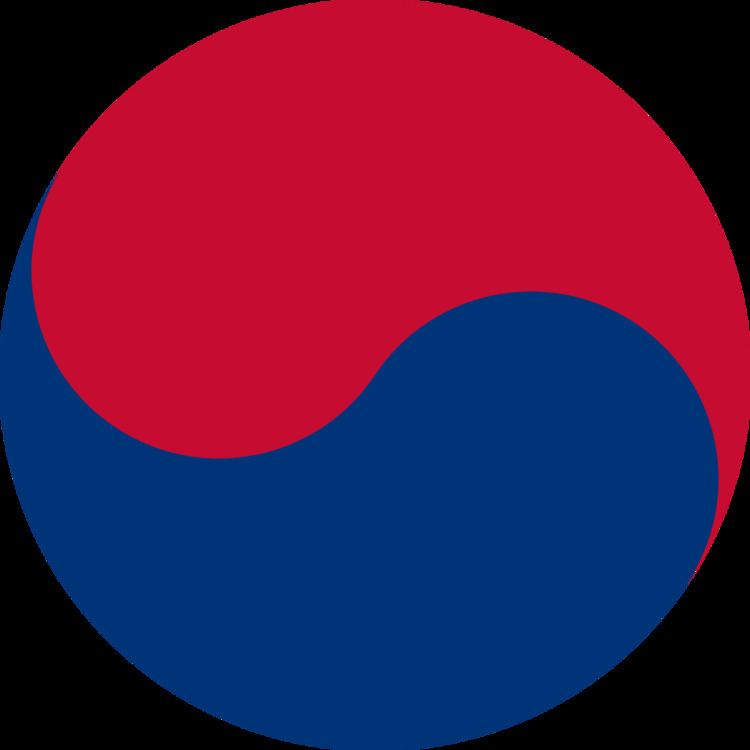Hangul 태극 Revised Romanization Taegeuk | Hanja 太極 McCune–Reischauer T'aegŭk | |
 | ||
Taegeuk (Hangul: 태극; Hanja: 太極, [tʰɛgɯk̚]) is the Korean form of the Chinese term Taiji "supreme ultimate".. The Korean term more specifically refers to the graphical symbol (taijitu) composed of interlocking spirals. This symbol chosen for the design of the national flag in the 1880s, known as taegeukgi (hangul: 태극기, where gi means "flag"). The taegeuk is commonly associated with Korean Taoism philosophical values as well as Korean shamanism.
Contents
History
The taegeuk has been in use for the majority of written history of Korea. The origins of the interlocking-spirals design can be traced to as early as the Goguryeo or Silla period, e.g. in the decoration of a sword, dated to the 5th or 6th century, recovered from the grave of Michu of Silla, or an artifact with the taegeuk pattern of similar age found in the Bogam-ri tombs of Baekje at Naju, South Jeolla Province in 2008. In the compound of Gameunsa, a temple built in AD 628 during the reign of King Jinpyeong of Silla, a stone object, perhaps the foundation of a pagoda, is carved with the taegeuk design.
In Joseon, the design was used to represent Daoism in Korea and to express the hope for harmony of yin and yang.
South Korean flag
The taegeuk symbol is most prominently displayed on South Korea's national flag, called the taegeukgi (along with four of the eight trigrams used in divination). Because of the taegeuk's association with the national flag, it is often used as a patriotic symbol, as are the colors red, blue, and black. The “geon” trigram (☰) represents the heaven, spring, east, and justice. The “gon” trigram (☷) symbolizes the earth, summer, west, and vitality, the “gam” trigram (☵) the moon, winter, north, and wisdom, and the “ri” trigram (☲) the sun, autumn, south, and fruition. The four trigrams supposedly move in an endless cycle from “geon” to “ri” to “gon” to “gam” and back to “geon” in their pursuit of perfection. The white background symbolizes the homogeneity, integrity and peace-loving nature of the Korean people. Traditionally, Koreans often wore white clothing, earning the nickname “white-clothed people” and therefore the color white epitomizes the Korean people.
Tricolored Taegeuk
A popular variant in Korea is the tricolor taegeuk (samsaeguitaegeuk 삼색의태극 or samtaegeuk 삼태극), which adds a yellow lobe or "pa" (hanja: 巴 Hangul: 파 ). The yellow is taken as representing humanity, in addition to the red and blue representing earth and heaven respectively. It is frequently seen as a design on the face of hand fans.
A rendition of the tricolored taegeuk also appeared in the official logo of the 1988 Summer Olympics accompanied by the five Olympic rings. A similar symbol is used by the Miss Asia Pacific World Beauty Pageant, which was hosted in South Korea from its inception in 2011 until 2014, and most recently hosted in Thailand in 2015.
Paralympics symbol
The first designated Paralympic logo, created for the 1988 Summer Paralympics in Seoul, was based on a traditional the pa {Hangul: 파; Hanja: 巴}, the spiral components making up the taegeuk symbol. In March 1992, the Paralympic symbol was changed to a version utilizing only three pa. This was not fully adopted until after the 1994 Winter Paralympics in Lillehammer, Norway, since the Lillehammer Paralympic Organizing Committee had by then already started a marketing program based on the five-pa version. The three-pa version remained in place from the close of the Lillehammer Games through the 2004 Summer Paralympics in Athens, Greece.
